- $740,000 by Jobs for Nature (Public Waterways and Ecosystems Restoration Fund), Ministry for the Environment)
- $450,000 by Kānoa Regional Economic Development & Investment Unit (Climate Resilience Fund), Ministry of Business, Innovation and Employment
- $176,000 by Waikato River Authority
- $145,000 by Genesis Energy
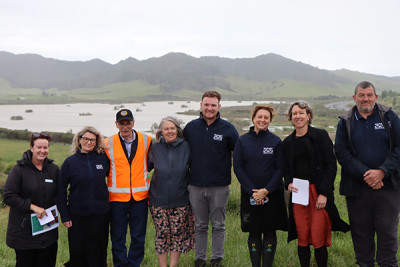
Lake Kimihia Restoration team from Waikato Regional Council.
COVID-19 ended up being a “game changer” for one riverine lake in the Waikato region.
Lake Kimihia, about 5 kilometres northeast of Raahui Pookeka-Huntly, had been completely drying out during some summers, and while there was a willingness by all stakeholders to restore the water levels to year-round, it was never going to be a cheap or easy fix.
Then in 2020 the COVID-19 pandemic hit, and central government announced funding for shovel ready infrastructure and environmental restoration projects to help stimulate the economy.
“This was a real game changer for Lake Kimihia,” Waikato Regional Council’s Lower Waikato Zone Manager Sarah Lealand told those gathered on-site last week to celebrate the completion of a three-year project to restore the water level and surrounding wetland habitat.
“We put the restoration of Lake Kimihia forward as a shovel ready project and also applied to the Waikato River Authority for funding to support restoration of the wetland habitat – and both applications were a success.”
Lake Kimihia, which is on public conservation land and is connected to the Waikato River, was once over 300 hectares in size and 3 metres deep and a very reliable source of mahinga kai (food gathering) for mana whenua. It was said that you could hear the tuna as they passed through the catchment during a tuna heke (migration to sea to spawn).
However, the lake is now only about a fifth of its original size and much shallower (600 millimetres), mostly due to coal mining in the area between 1887 and 1910.
Some summers it had been completely drying out, causing significant loss of habitat and even leaving fish dead on the lakebed.
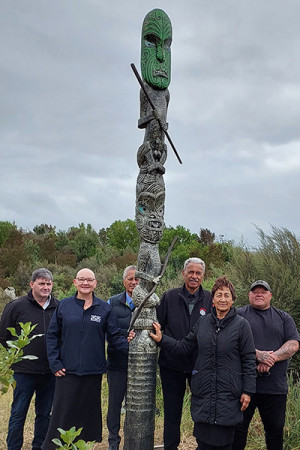
From left, councillor Robert Cookson, chair Pamela Storey, kaumatua Sam Toka, Waahi Whaanui CEO Hori Awa, Waahi Whaanui trustee Te Wairemana Subritzky and pou carver TK George.
A minimum lake level was set by Waikato Valley Authority in 1987, and a temporary weir installed, but over time the weir deteriorated and failed, affecting the lake’s water levels.
Local group Friends of Lake Kimihia were being particularly vocal about their concerns for the wellbeing of the lake, including holding a protest onsite on the opening day of the Huntly section of the Waikato Expressway, which is right next to the lake.
An engineer’s report had recommended that the weir and associated earth bund be upgraded and relocated – at a cost of in excess of $1 million.
The shovel ready and Waikato River Authority funding has enabled the construction of a new bund, weir and culverts to ensure the minimum lake level, but also allowed the installation of pest fish barriers, 4.32 kilometres of fencing to exclude livestock from the lake and wetland areas, and the planting of 28,308 eco-sourced native plants. Genesis Energy also later contributed funding to the project to support cultural and environmental deliverables.
Local landowners have retired 10.39ha of land, including for part of the new bund and for the riparian planting, while mana whenua have been involved in ecological monitoring and cultural enhancements of the area. In November, as part of ecological monitoring following construction, seven nets were set and returned a total of 586 fish: 403 shortfin tuna and one long fin tuna, which were released back into the lake, and 178 invasive fish (predominantly catfish and five koi).
A pou of Chief Pakaraaka and his wife, Whaawhaakia, who resided on the shores of Lake Kimihia in the 1600s, has been erected next to the lake and is visible to motorists travelling south on State Highway 1.
Waahi Whaanui CEO Hori Awa said he was proud of how far the project had come.
“This land was all Lake Kimihia back in the day,” Hori told those gathered at the site opening. “It may not be able to get back to what it used to be, but we can look after what we have got and do as much as we can.
“Two years ago, the lake was very dry, and it hasn’t been dry since the work was done. This wouldn’t have happened if we hadn’t worked together.”
Farmers Trish and Tim Foy, who allowed the construction of a site accessway on their property and retired land for a large section of the earth bund and for habitat restoration, said they were pleased to help return life to the lake.
“We do it because we have a duty of care; it’s about looking after the environment,” said Trish.
“The lake was completely dry and we had koi carp dying in the paddocks.
“There is a lot more birdlife now; we’re seeing more bittern now that the work has been done.”
Rex Ashby, from the Friends of Lake Kimihia, said he was so happy when he saw the loads of eels being caught as part of the ecological monitoring.
“We really wanted to get the lake fixed, and we protested when the motorway opened,” said Rex, who has been duck shooting on the lake since the early 1970s. “We rattled a few doors here and there, and we are very pleased. The lake is full of tuna again.”
Waikato Regional Council chair Pamela Storey said projects like Kimihia don’t happen unless everyone works together.
“But in particular, none of this could have happened without the extraordinary commitment of Trish and Tim Foy.”

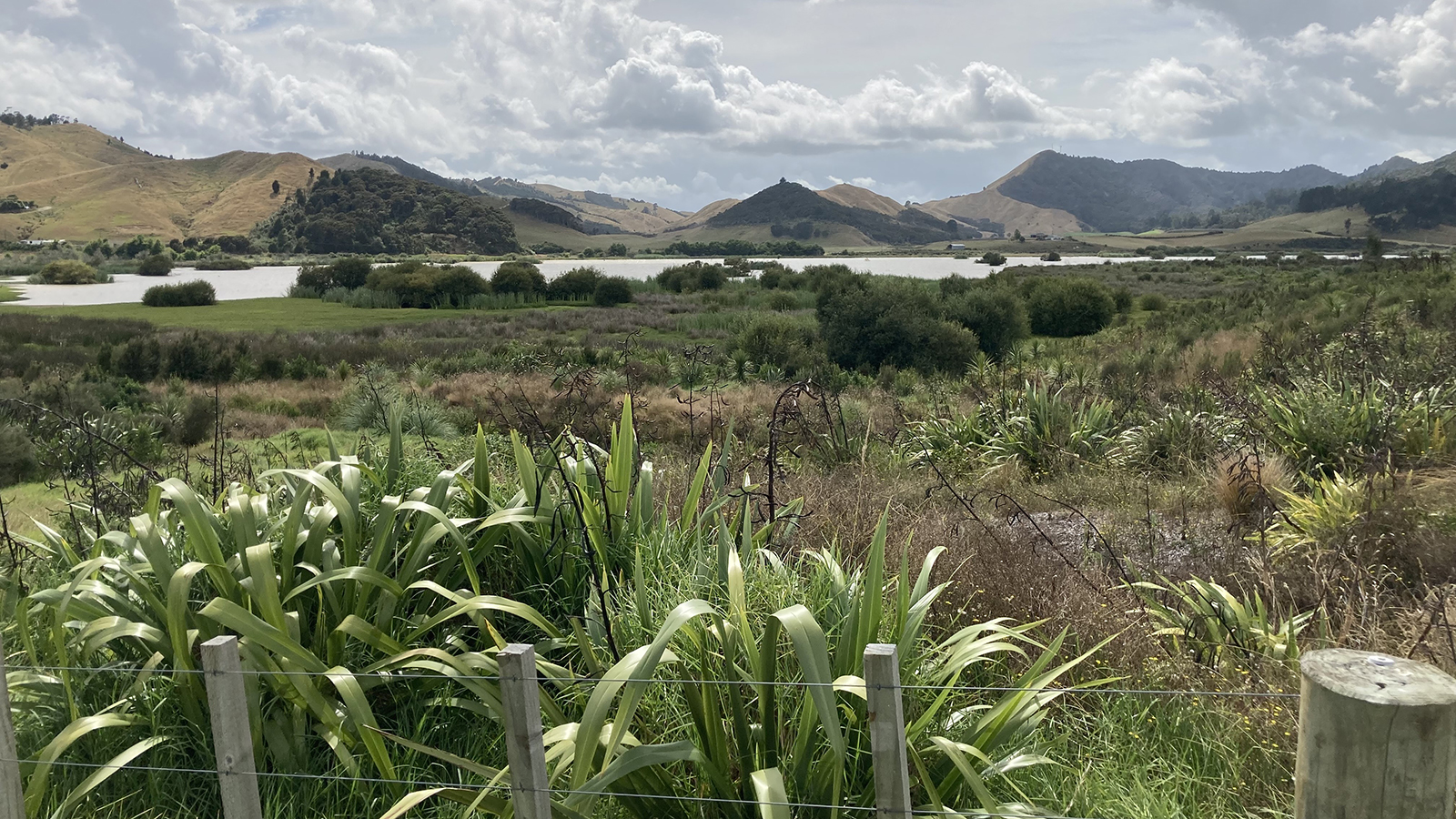
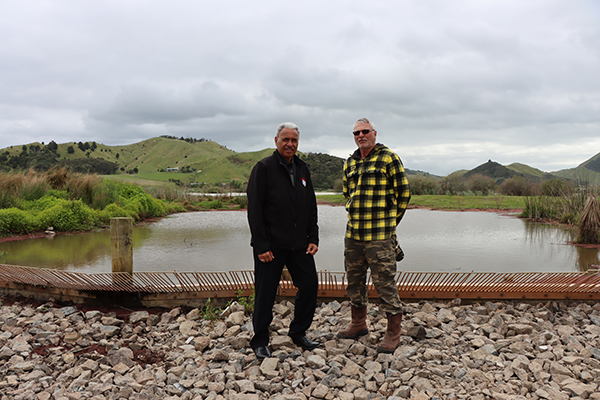
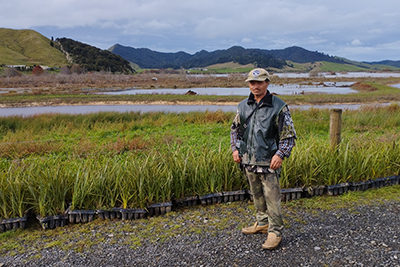
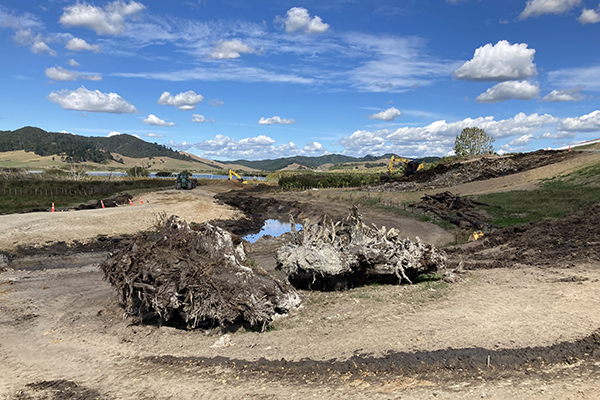
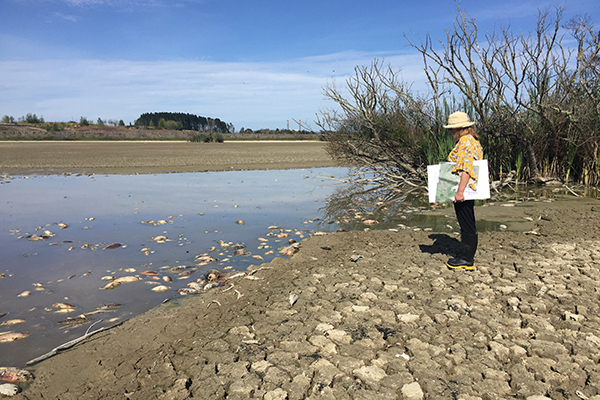

To ask for help or report a problem, contact us
Tell us how we can improve the information on this page. (optional)